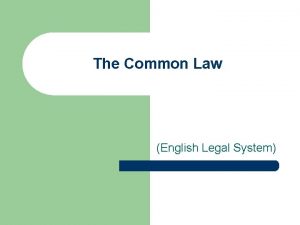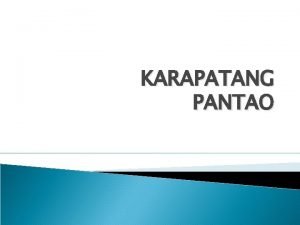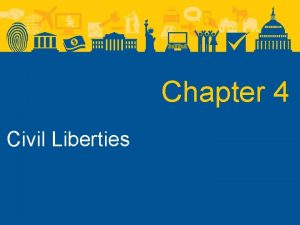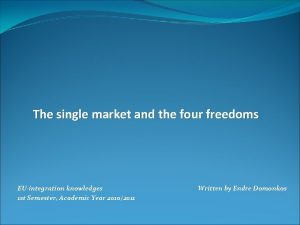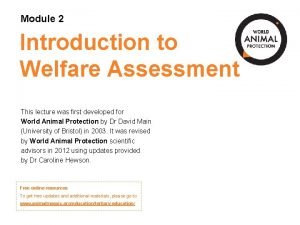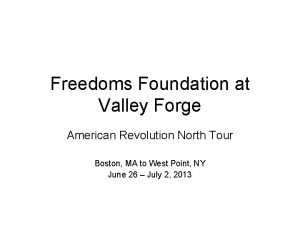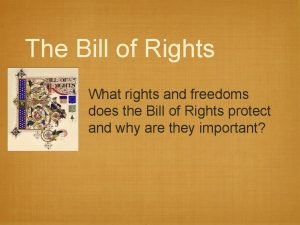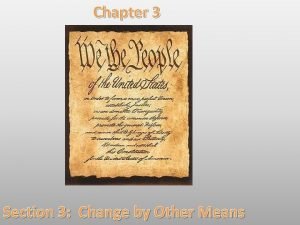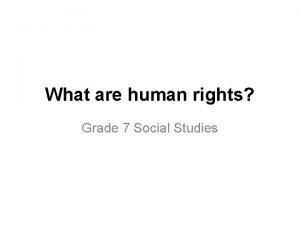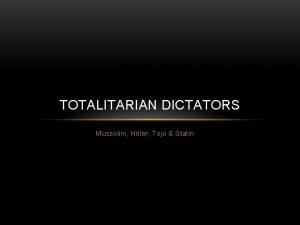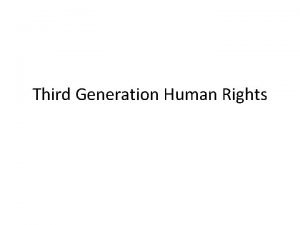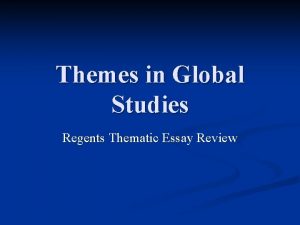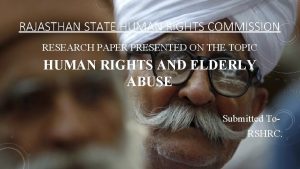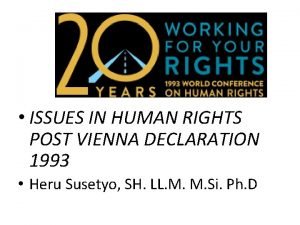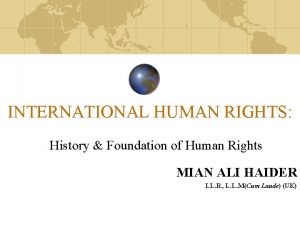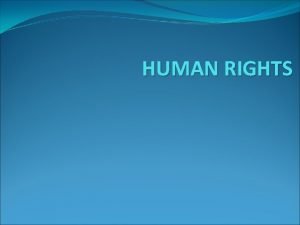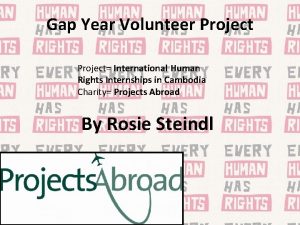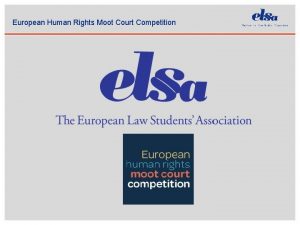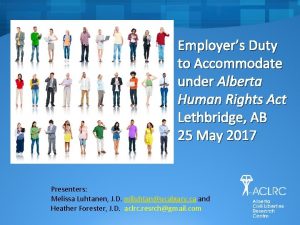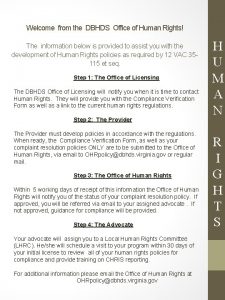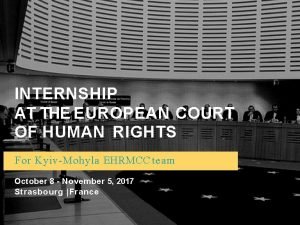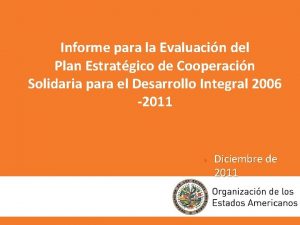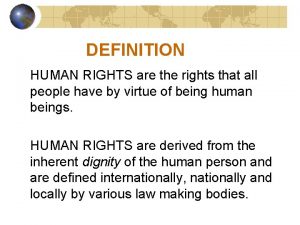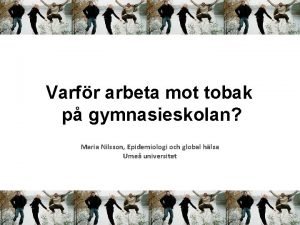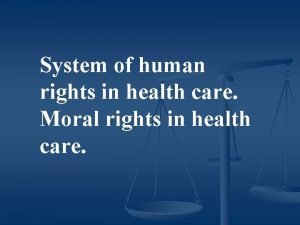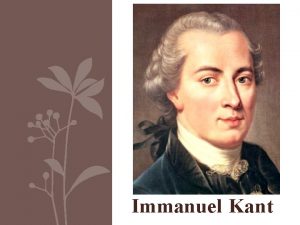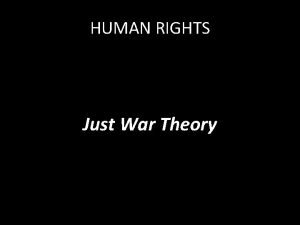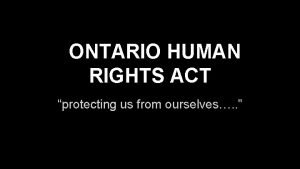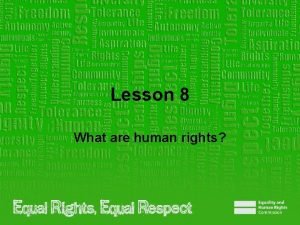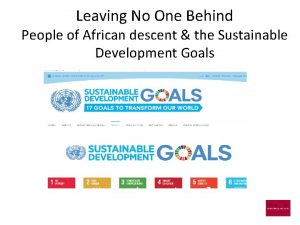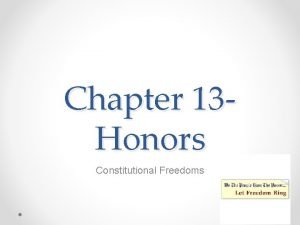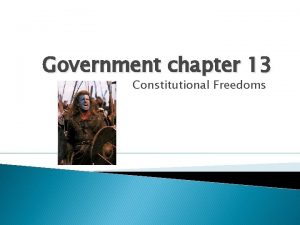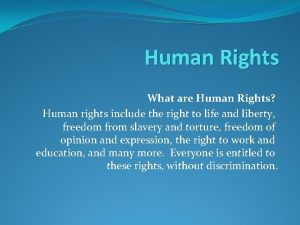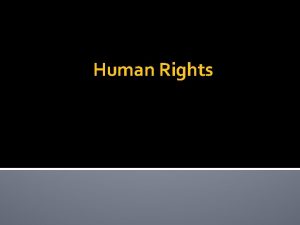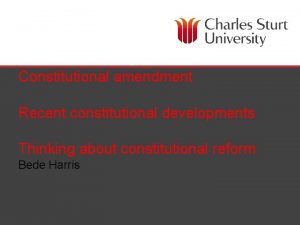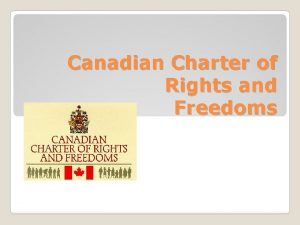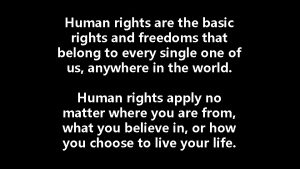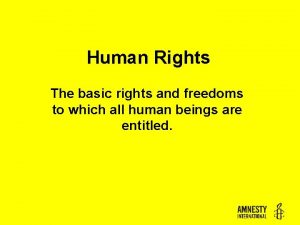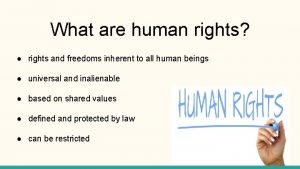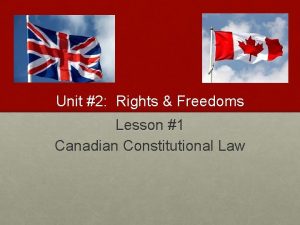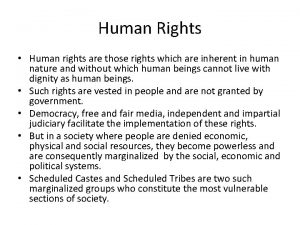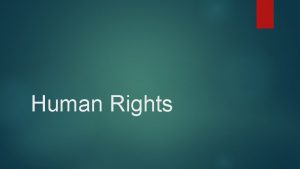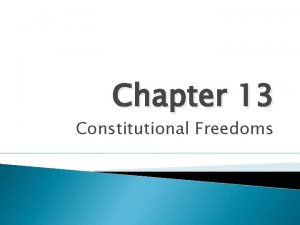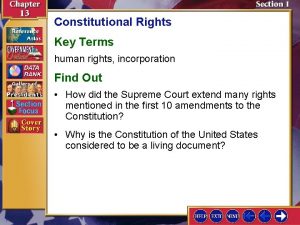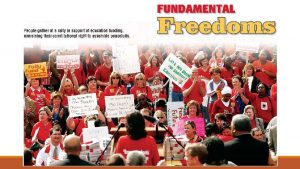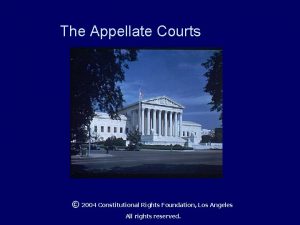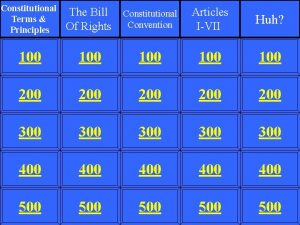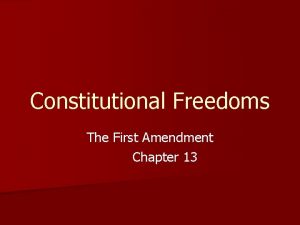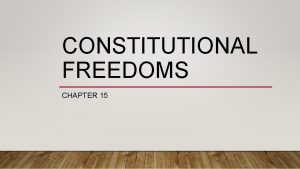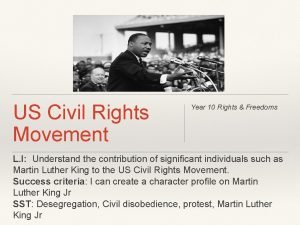Constitutional Freedoms Chapter 15 Human Rights fundemental freedoms















































- Slides: 47

Constitutional Freedoms Chapter 15 Human Rights - fundemental freedoms

The First Amendment Protects people’s Freedom of Speech Freedom of religion Freedom of press Freedom of assembly Freedom of petition

Freedom of Speech Lesson 1 Complete activity on pg 440 – discuss

The Supreme Court Rules on Types of Free Speech A. Free speech includes verbal expression of thought and opinion (Pure Speech) and symbolic speech, using actions and symbols (Symbolic Speech). B. Because symbolic speech involves action, it may be limited by government restrictions that do not apply to free speech. (Tinker v. Des Moines School District) pg. 443

Compare pure speech and symbolic speech. In what ways are they similar? In what ways are they different?

Content Restrictions on Speech Categories -obscenity -defamation Slander (spoken) Libel (written) -”Fighting Words” -Commercial Speech -Seditious Speech

The Supreme Court Rules on Regulating Speech A. The rights of free speech must be balanced against the need to protect society. B. Free speech may be limited when it clearly presents an immediate danger, as in the Schenck case (1919). C. Free speech can be restricted even if it only tends to lead to illegal action (the bad tendency doctrine), given society’s need to maintain public order.

D. The Court has ruled that the First Amendment freedoms have a preferred position because they are more fundamental than other freedoms; laws limiting them are presumed unconstitutional. E. The Court has held that people are free to speak out in support of political objectives; however, free speech does not protect those who advocate immediate and specific acts of violence.

Free Speech in Public Schools School authorities can regulate students’ free speech at school events and during activities. Bethel v Fraser (1986) – ruled that schools can punish lewd or indecent speech, even though the speech is protected outside school Hazelwood School District v Kuhlmeier (1988) – ruled that school officials can regulate school speech in school sponsored activities, like the school newspaper and theater productions

Do you agree or disagree with limits on students’ freedom of speech in public schools?

Lesson 1 Questions 1. What is the difference between pure speech and symbolic speech? 2. What are the five categories of speech not protected by the first amendment? 3. What are the two kinds of defamatory speech? 4. What did the Supreme Court establish in the United States v O Brien Court case (1968)? 5. How are students’ free speech rights different from their rights outside the school setting? 6. Describe the following Court Cases: Bethel School District v Fraser, Hazelwood School District v Kulhmeier, and Tinker v Des Moines 7. Why can’t enlisted personnel mock the president?

Freedom of the Press, Assembly, and Petition Lesson 2

Freedom of the Press – Prior Restraints Forbidden A. Prior restraint, or censorship in advance, is permissible only in cases directly related to the national security. B. In Near v. Minnesota (1931) the Court ruled that states could not stop the publication of a newspaper, because that action involved prior restraint. (the newspaper had cal the local officials “gangsters”) C. In the Pentagon Papers case in 1971, the majority ruled that the government could not stop the publication of secret government documents, because it would involve prior restraint. (discussing U. S. involvement in the Vietnam

Fair Trials and Free Press A. The First Amendment rights of a free press sometimes conflict with the Sixth Amendment’s guarantee of a fair trial. B. After the Sheppard case (1966), the Supreme Court described measures that courts might take to restrain press coverage, including moving the trial site, limiting the number of reporters in the courtroom, controlling repor conduct in court, keeping witnesses and jurors isolated from the press, andsequestering the jury. C. Gag orders barring the press from publishing certain types of information are illegal and are allowed only in unusual circumstances

D. After the Court ruled that reporters, like all citizens, must testify in cases if called and cannot refuse to reveal their sources of information, some states passed shield laws to protect the media from being forced to disclose confidential information in state courts.

New Media Internet 1. How can a judge issue a gag order broad enough to cover any journalist who wants to cover the story? 2. How can the defendant expect to find an unbiased jury? 3. Should a blogger be treated like a reported? 4. What do we do when an anonymous comment online is defamatory or fraudulent? Wikileaks 2010 – pg. 450

Free Press Issues A. The Founders viewed the press strictly as printed material; electronic media had not yet been invented. B. Radio and television do not enjoy as much freedom as other press media because they use the public airways. C. The Federal Communications Commission (FCC) regulates radio and television. That agency cannot censor broadcasts but may set standards

D. Movies and the Internet are protected by free press guarantees. E. Communities may regulate obscenity within limits acceptable to the courts. F. Advertising is commercial speech and thus receives less protection than purely political speech.

Freedom of Petition – We have the right to petition the government for redress of grievances - Signing a petition - Filing a lawsuit - Writing a letter or email - Testifying before tribunals - Collecting signatures for ballot initiatives .

Freedom of Assembly – People can participate in protests, parades, and other large events to show their unity and to show their support or opposition to a government policy. The gathering must be peaceful. - The freedom to assemble must be balanced with the need to maintain order. Which means the government can deny a group to meet on public land or require groups to get a permit

Public Assembly and Disorder A. When people assemble to advocate unpopular causes, police may have difficulty protecting them from violence and disorder. B. The Nazi party march in Skokie, Illinois, in 1977 illustrated the heckler’s veto: the public vetoes the rights of free speech and assembly of an unpopular group. C. Police may disperse a demonstration in order to keep the peace, but in the Gregory case (1969), the Court upheld the right of assembly by persons peacefully demonstrating in support of an unpopular cause.

Protection for Labor Picketing A. Labor picketing is different from other demonstrations; it seeks to persuade customers not to deal with a business whose workers are on strike B. Before 1940 the Supreme Court supported restraints on labor picketing, but in that year it ruled that picketing was a form of free speech; in the years since, forms of picketing have been limited in several key rulings.

Freedom of Association A. The right of free assembly includes the right of free association, including joining a political party, interest group, or other organization. B. Membership in groups advocating the use of force to overthrow the government, the Court has ruled, is not illegal; when members of such groups actually prepare to use such force, however, the acts are punishable.

Lesson 2 Questions 1. 2. 3. 4. 5. When can the government exercise prior restraint on the press? Discuss the New York Times v United States and Near v Minnesota court cases. What measures can the court take to insure a fair trial? Freedom of petition gives citizens the right to redress their grievances. How can they do this? (5 ways) Define Freedom to assemble.

Freedom of Religion Lesson 3 “ Congress shall make no law respecting an establishment of religion, or prohibiting the free exercise thereof…”

The Establishment Clause A. Forbids Congress from passing legislation to establish a single religion for the United States. B. The First Amendment’s guarantee of the free exercise of religion forbids Congress from passing laws limiting the practice of religion. C. In practice, religion is important to public life in the United States, and defining separation between church and state has been difficult. D. Establishment clause cases often involve religion and education.

E. Since the Everson ruling in 1947, the Court has ruled some forms of state aid parochial to schools constitutional but has rejected others. F. The Court has ruled state aid to parochial schools constitutional: Lemon Law 1. if the aid has a clear nonreligious purpose; 2. if its main effect is to neither advance nor inhibit religion; 3. if it avoids excessive government entanglement with religion.

G. The Court has allowed released time for religious instruction during the school day if the instruction is provided away from the public schools. Mc. Collum v. Board of Ed. H. The Court has struck down organized school prayers but has allowed student religious groups to hold meetings in public schools; debate on the Court’s rulings involving religion has been heated and sharply divided. Engel v. Vitale I. The Court also has ruled that states cannot ban the teaching of evolution in public schools or require the teaching of creationism.

J. Other interpretations of the establishment clause have involved Christmas nativity displays in public places and prayers at government meetings.

The Free Exercise Clause’s Landmark Rulings A. The Supreme Court makes an important distinction between religious belief and practice. B. Religious freedom cannot justify behavior or practices that violate laws protecting the health, safety, or morals of the community. C. Amish parents could not be forced to send their children to public school beyond eighth grade; children of Jehovah’s Witnesses could not be required to salute the flag in the classroom. Court Cases Wisconsin v. Yoder 1972 Minersville School District v Gobitis 1940 West Virginia State Board of Education v Barnette 1943

Lesson 3 questions 1. There are two clauses of the First Amendment that deals with religion. Name and explain each clause. 2. What was the outcome of the Everson v Board of Education (1947)? 3. What three part test does the Supreme Court use to determine if government aid to parochial schools is constitutional? 4. What was the outcome of the following court cases: - Engle v Vitale - Reynolds v United States - Minersville School District v Gobitis - West Virginia State Board of Education v Barnette

THE FOURTEENTH AMENDMENT LESSON 4

What did the Fourteenth Amendment say? • Granted citizenship to all persons born in the United States • Guaranteed due process of law from all state governments • Guaranteed equal protection of the laws from all state governments

Citizenship – important Court Cases & terms • Dred Scott v Sanford 1857 • Indian Citizenship Act 1924 • Jim Crow Laws • Plessy v Ferguson 1896 • Brown v Board of Education 1954

Due Process • Procedural Due Process – means that the government must follow fair procedures if it is going to deprive someone of life, liberty, or property. • Substantive Due Process – means that the laws themselves have to be fair. A law or government action cannot unreasonably interfere with a fundamental or basic right. • Equal Protection – prohibits government actions from unreasonably discriminating between different groups of people

EQUAL PROTECTION • Rational Basis – A rational bases exists when there is a logical relationship between the treatment or classification of some group of people and the purpose of the law. • Strict Scrutiny – a standard of judicial review for challenged policy in which the court presumes the policy to be invalid unless the government can demonstrate a compelling interest to justify the policy

Cont. • Substantial Relationship - a standard of judicial review that examines whethere is a close connection between the law of practice and its purposes; specifically, laws that classify based on gender must serve an important government purpose

INCORPORATION OF THE BILL OF RIGHTS • Incorporation Doctrine - the process by which the Bill of Rights was extended to the states and localities • Selective Incorporation - the process by which the Supreme Court decided on a case – by – case basis which federal rights also applied to the states

Lesson 4 Questions 1. What is guaranteed in the Fourteenth Amendment? 2. What was the outcome of the Dred Scott v Sanford (1857) court case? 3. What did the Indian Citizenship Act (1924) grant? 4. What was the outcome of Plessy v Ferguson (1896) and Brown v Board of Education (1954)?

Equal Protection and Discrimination lesson 5 • Protection from unfair Discrimination • When is discrimination unconstitutional? • What is discrimination? • Brown v Board of education (1954) • Civil Rights Movement • Dr. Martin Luther King, jr. • • • Non violent Sit-ins The Civil Rights Act of 1964 The voting Rights Act of 1965 The Civil Rights act of 1968, 1974 and 1988

Cont. • Discrimination based on National Origin • Hernandez v Texas • Discrimination Based on Sex and Gender • Women’s rights convention held in 1848 • Picket • Equal Rights Amendment • Equal Pay Act 1964 • Civil rights Act 1964 • Education Amendment Act 1972 (title IX)

Cont. • Combating Other Forms of Discrimination • Discrimination Based on Sexual Orientation • 2010 Congress passed a bill repealing a ban on openly gay people serving in the military • 2013 the Supreme Court ruled that the Federal Government was required to recognize valid same-sex marriages for the purposes of federal law and benefits. • By 2014 11 states have passed laws legalizing same-sex marriages • 21 states allow same-sex marriage with out a law • 18 states still prohibit same-sex marriage

Cont. • Discrimination based on Disability • American Disabilities Act • Individuals with Disabilities Education Act

AFFIRMATIVE ACTION • Affirmative Action – policies that give preference to women or minorities for jobs, promotions, admission to schools, or other benefits, in order to make up for past or current discrimination -Regents of the University of California v Bakke (1978) -Outside of Education

THE RIGHTS TO BEAR ARMS AND TO PRIVACY LESSON 6 • The Second Amendment • The Gun Control Act of 1968 • Right To Privacy • Reproductive Rights to Privacy • Griswold v Connecticut • Roe v Wade

Cont. • Information Gathering and Privacy • Telecommunication – technology • Government Surveillance • Foreign Intelligence Surveillance Agency (1978) • USA Patriot Act (2001)

Lesson 5 & 6 questions 1. 2. 3. 4. What was the Civil Rights movement? Who was Martin Luther King, Jr. ? What is Affirmative Action? What is the incorporation doctrine?
 Examples of common law
Examples of common law Karapatang sibil example
Karapatang sibil example Chapter 19 civil liberties first amendment freedoms
Chapter 19 civil liberties first amendment freedoms Civil liberties first amendment freedoms
Civil liberties first amendment freedoms Four freedoms of the eu
Four freedoms of the eu Four freedoms of the eu
Four freedoms of the eu Welfare inputs and outputs
Welfare inputs and outputs Freedoms foundation teacher programs
Freedoms foundation teacher programs Freedoms
Freedoms Freedoms
Freedoms Change by other means
Change by other means Positive rights and negative rights
Positive rights and negative rights Littoral rights real estate
Littoral rights real estate Duties towards self
Duties towards self Legal rights and moral rights
Legal rights and moral rights What are negative rights
What are negative rights Negative rights
Negative rights Negative rights vs positive rights
Negative rights vs positive rights Negative right
Negative right 8.3 human needs
8.3 human needs Chapter 8 human needs and human development
Chapter 8 human needs and human development What is rights in social studies
What is rights in social studies What did tojo do to people who opposed him
What did tojo do to people who opposed him First generation human rights
First generation human rights Theories of human rights
Theories of human rights Global regents thematic essay topics
Global regents thematic essay topics State human right commission rajasthan
State human right commission rajasthan Definition of campaign in life orientation
Definition of campaign in life orientation Vienna declaration of human rights
Vienna declaration of human rights The meaning of human rights
The meaning of human rights First generation of rights
First generation of rights Projects abroad human rights office
Projects abroad human rights office European human rights moot court competition
European human rights moot court competition Alberta duty to accommodate
Alberta duty to accommodate Dbhds licensing regulations
Dbhds licensing regulations Traineeship european court of human rights
Traineeship european court of human rights Human rights day
Human rights day Fundamental rights definition
Fundamental rights definition Categories of human rights
Categories of human rights Human rights uconn
Human rights uconn Human rights watch
Human rights watch Classification of human rights
Classification of human rights Immanuel kant human rights
Immanuel kant human rights Immanuel kant human rights
Immanuel kant human rights Ontario human rights commision
Ontario human rights commision Human rights easy
Human rights easy Health is human rights
Health is human rights Ratana
Ratana
